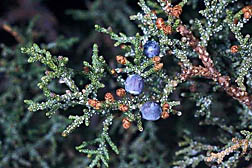This page has been archived and is being provided for reference purposes only. The page is no longer being updated, and therefore, links on the page may be invalid.
|
|
Spread of Western Juniper Seeds Studied
By Marcia WoodNovember 4, 2009
Aromatic, evergreen foliage and plump, dusty-blue to nearly purple berries make western juniper appealing, whether it's a small shrub or a lofty tree. The trouble is, during the past 100 years or so, some once-open western juniper woodlands in this species' native range of California, Oregon, Nevada, Idaho and Washington have become dense stands.
The result is that fire-danger ratings can skyrocket, according to Agricultural Research Service (ARS) ecologist William S. Longland at the agency's Exotic and Invasive Weeds Research Unit in Reno, Nev. What's more, the stands crowd out tasty, nutritious understory plants that cattle and wildlife could otherwise graze or browse.
This year, Longland developed new studies to determine whether a natural process known as diplochory gives western juniper a competitive advantage. In published research, Longland explains that diplochory is a two-step process in which seeds are handily dispersed by two different sets of "agents."
In the first step of what could turn out to be diplochory in western juniper, birds such as robins and Townsend's solitaires pluck western juniper's chunky berries from its branches, then fly away to places where they can safely eat their prizethe berry's fleshy fruit that surrounds its small, hard seed. This feeding helps survival of the seed by moving it away from the competition of the parent trees.
Seeds that birds swallow may pass through their digestive systems, land on the ground, and, in what may be the second phase of diplochory, be carried away and buried by small mammals like deer mice or kangaroo rats. Burying hides the seeds from other seed-eaters and helps the seeds germinate.
In a preliminary study, Longland's network of motion- or heat-sensor-activated cameras captured real-time snapshots of birds and mammals holding juniper berries or seeds in their beaks or paws. Though these caught-in-the-act candids strongly suggest diplochory at work, more evidence is needed. That might come from follow-up research by Longland and co-investigators Steve Vander Wall of the University of Nevada-Reno and Diana Hiibel of the Reno-based Animal Ark Wildlife Sanctuary.
ARS is the principal intramural scientific research agency of the U.S. Department of Agriculture.

